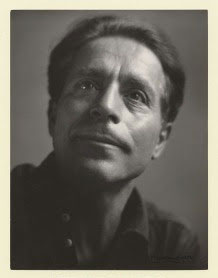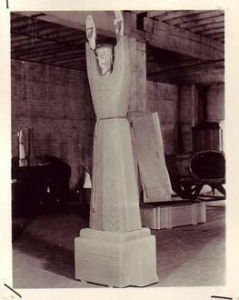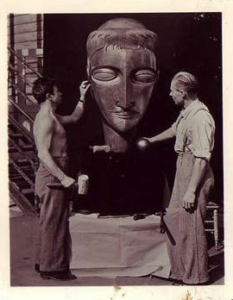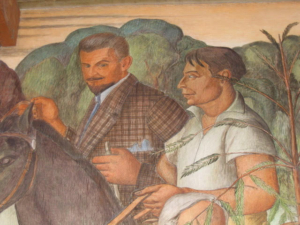
Beniamino-Bufano,1938
Photo: Johan Hagemeyer. Courtesy Bancroft Library, UC Berkeley.
Of all the controversies that New Deal art had provoked in San Francisco, such as the Coit Tower and Rincon Annex murals, few equaled that which swirled around what would have been the largest WPA sculpture in the country. But sculptor Beniamino Bufano thrived on controversy, so his proposed 180-foot stainless steel statue of St. Francis mounted on the summit of Twin Peaks was sure to serve as a lightning rod for controversy, as well.
Born in Italy around 1890, Bufano studied art in New York City before creating sculpture for the 1915 World’s Fair in San Francisco. The city became his home despite extensive travels throughout his life. A prolific sculptor and major town character, he was variously described as brilliant, eccentric, erratic a congenital liar, but “colorful” covered all bases.

14-foot model for the St. Francis statue at Bufano’s San Francisco studio. Courtesy, NARA.
In a 1964 interview recorded for the Archives of American Art, regional WPA art director, Joseph Danysh, recalled that “Bufano was a child. Bufano was a great artist: the most divinely naïve human being I ever met in my life. He got me into more trouble than women have ever gotten me into or money has ever gotten me into or my drinking or anything else.” Yet Danysh brought that trouble on himself when he championed a statue that would have towered nearly twice as tall as sculptor Paul Landowski’s famous Christ the Redeemer overlooking Rio de Janiero and probably would have attained similar worldwide fame.
Unlike Landowski’s cruciform statue, the arms of Bufano’s St. Francis would have been upraised in a gesture of benediction, perhaps to simplify the engineering challenge presented by the outstretched arms of Rio’s Christ. It would have loomed over the saint’s namesake city, terminating Market Street with what Bufano called “the symbol of a new religion. It symbolizes the brotherhood of man — stripped of pretense — as close to a universal interpretation as I could make it.”

Bufano and an assistant work on the scale model of St. Francis sculpture. Courtesy, NARA.
Chicago architect Daniel Burnham earlier had proposed a titanic triumphal statue for Twin Peaks in his 1905 Parisian plan for San Francisco, and other architects did so as well, but Bufano’s sleek creation came nearest to realization with Danysh’s support and WPA funding.
Derided by critics as “The Stick-up,” it roiled Art Commission meetings and newspaper columns for several years in the mid-30s. One hundred forty-seven prominent local artists signed a petition in its defense with painter Roy Boynton declaring, “It is probably the most original conception of St. Francis since Giotto’s frescoes,” while being at the same time “uniquely modern in its material and execution and timeless in its form.” The Allegheny Steel Company offered to donate stainless steel for the body while the face would have been copper.
The statue caused dissension within the Church. Supported by San Francisco Archbishop Mitty among other Catholics, prominent Franciscan Father George disagreed, calling it “inartistic.” “It is a monstrosity. It disgraces our order, and it disgraces St. Francis.” The city’s Parks Commission said that maintenance would cost $10,000 per year and opposed it for that reason.
At a fiery meeting on February 3, 1937 that made national news, the evenly-split Arts Commission only voted to approve Bufano’s creation when Mayor Angelo Rossi cast a tie-breaking vote.

Joseph Danysh (left) and Benny Bufano depicted by Lucien Labaudt in his WPA frescoes at the San Francisco Beach Chalet. Photo Credit: Gray Brechin
Following a feasibility study, the Board of Supervisors dedicated ten acres of Twin Peaks to the statue in 1938. Danysh claimed that construction would employ many needy artists but the project was delayed for unknown reasons for years until preparation for the war demanded steel for other purposes.
Twin Peaks remains unencumbered by Bufano’s colossus, a would-be symbol of universal brotherhood that might have looked out over the city that birthed the United Nations.
Gray Brechin is a geographer and Project Scholar of the Living New Deal. He is the author of Imperial San Francisco: Urban Power, Earthly Ruin.







